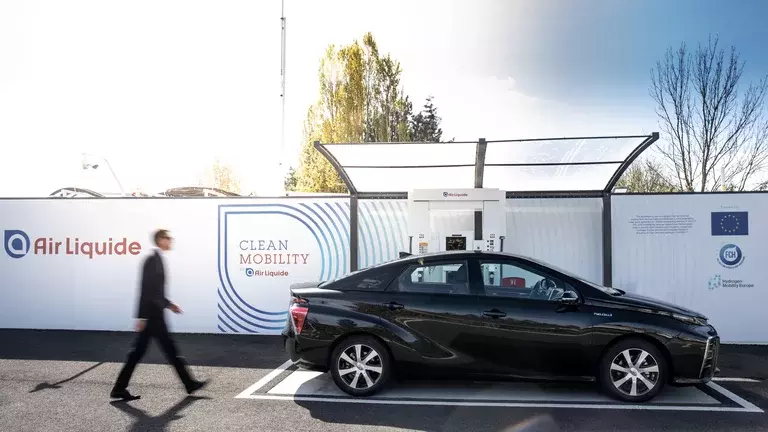Revolutionizing clean transportation
Hydrogen is at the heart of the clean transport revolution for road, water and air, reducing greenhouse gas emissions, pollution in our cities, and dependency on oil-based fuels.
Answering heavy mobility challenges
Transport accounts for 25% of global emissions, 70% of which directly caused by road transport (freight and passengers). Whilst existing technologies will keep improving, the development of new solutions is unavoidable to reach the Paris agreement objectives. Hydrogen is one of the key solutions to tackle the mobility challenge, and it is particularly well suited to answer the needs of intensive mobility and heavy transport
Liquid hydrogen
Accelerating hydrogen road mobility
There are already around 50,000 fuel cell vehicles on the roads (mostly cars), representing a global demand of 100 tonnes per day.
Hydrogen: a key solution for heavy mobility
Hydrogen is well positioned as a solution to decarbonize intensive mobility (public and freight transport) because it answers unavoidable criterias for decision makers: weight, space and cost amongst others. With larger vehicles or used more intensely, hydrogen can offer the best of all worlds: a short refueling time for a long range autonomy.
Depending on its usage, the need in hydrogen depends on the vehicule type, ranging from 0.35 kg per day for a car, to 30 kg for a bus, and 70 kg for a truck.
~4,000
hydrogen buses already in operation worldwide
BUS
Buses are covering very specific routes in small areas at fixed times. Such a high predictability level makes them a prime choice for transition towards zero emission. µuses are today’s fastest growing segment in hydrogen mobility. Fuel cell buses, refueling stations and hydrogen are now available on the market.
What are the benefits of hydrogen for buses?
- Fast refueling time: 10 min
- Autonomy: up to 100 km range with 8 kg of hydrogen
- Noise reduction, a major impact in dense areas.
- Avoid high capacity grid connection
- Cold, hot, hilly environment
- Long buses with many passengers
> 50%
zero-emission trucks will run on hydrogen by 2030
Heavy-Duty
Heavy Duty is one of the most demanding mobility segments: trucks need to be operational for long periods of time over long distances. Hydrogen is the best suited answer to decarbonize heavy-duty transport.
In 2030, the production of fuel cell vehicles could represent 2.5 million vehicles, of which 20% could be heavy-duty. But with their intensive use, these could represent nearly 60% of the mobility market’s need in hydrogen.
What are the benefits of hydrogen for heavy duty vehicules?
- Fast refueling time: 15 min
- Autonomy: up to +,000 km range
- Payload parity with diese
- Exigen environment
45,000+
Hydrogen light-duty vehicles already on the road
Light-Duty fleets
.Hydrogen energy is particularly well suited to light duty captive fleets such as taxi, utility vehicles, or even forklifts. These fleets are operating in specific areas during predicatable shifts, allowing for the corresponding infrastructure to be deployed where needed
What are the benefits of hydrogen for light-duty fleets?
- Fast refueling time: less than 5 min
- Autonomy: up to 800 km range
- High fleBibility, high use rates operations
- Zero-emission vehicles
Fuel Cell Electric Light Duty vehicles are convenient solutions for transport operators looking for long range and easy refuelling operations. Light-duty vehicles and related infrastructures are already being deployed in Europe, Asia and North America with over 45,000 already on the road.
Our hydrogen refueling stations
We are contributing to the deployment and growing use of hydrogen by developing technologies that implement it. We offer standardized or customized solutions that meet the customer s needs: from design to integration, manufacture, installation, commissioning and maintenance of hydrogen stations. Our solutions are dedicated to filling cars, buses, trucks, trains and, in the near future, ships and aircraft.
Our stations portfolio
We offer the most extensive portfolio of hydrogen refueling stations and related services for all your clean mobility hydrogen energy needs. Our team will support you at every stage of your project, from the choice of the hydrogen source, design (appropriate refueling times, footprint), installation, start-up, operation, and maintenance.
2035
first commercial hydrogen aircraft
Decarbonizing aviation, from the ground to the air
The aviation industry has committed to being net zero by 2050. Its climate impact goes far beyond CO2 emissions (NOx). For aircraft as well as for airports, liquid hydrogen can best answer the challenge of decarbonizing aviation. As the first hydrogen-powered commercial aircraft are expected by 2035, airports need to adapt their infrastructures as of today.
Hydrogen can be used for many applications in and around the airport. Itwill be used for propulsion either by direct combustion or by powering a fuel cell. hydrogen can also serve other ground mobility usages, notably heavy duty mobility or light ground support equipment.
What are the benefits of hydrogen for the aviation?
-
The cheapest decarbonised aviation fuel
-
The only low carbon alternative to kerosene with synfuels (CO2 + NOx)
-
High energy density
120K
ships worldwide in commercial fleet today
Creating sustainable pathways to a zero carbon maritime industry
The maritime transport sector accounts for 3% of CO2 emissions per year on a global scale.
Hydrogens very high energy density allows a zero-emission maritime transportation, while having minimal impact on cargo space.
If as of now, almost the entire fleet uses diesel engines, new and greener propulsion systems are an increasingly important subject for the sector. Hydrogen is expected to play a key role.
We offer new avenues for zero-emission mobility in the maritime transport sector while bringing public awareness and technological innovation for waterborne transportation.
What are the benefits of hydrogen for the maritime industry?
- Zero-emission
- Higher operational range vs batteries
- Suited for the average power requirements
Hydrogen from production to distribution
Air Liquide is present at every step of the hydrogen value chain






